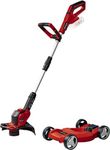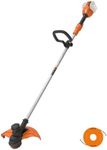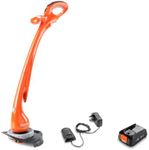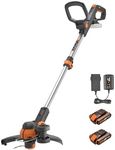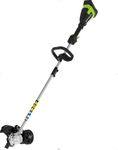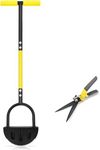Buying Guide for the Best Lawn Edgers
Choosing the right lawn edger can make a significant difference in maintaining a neat and tidy lawn. A lawn edger is a tool used to create distinct boundaries between your lawn and other areas like driveways, sidewalks, or flower beds. When selecting a lawn edger, it's important to consider the size of your lawn, the type of terrain, and your personal preferences for handling and maintenance. Understanding the key specifications will help you make an informed decision that best suits your needs.Power SourceThe power source of a lawn edger determines how the tool is powered and can significantly affect its performance and convenience. There are three main types: gas-powered, electric (corded), and battery-powered (cordless). Gas-powered edgers are typically more powerful and suitable for larger lawns or tougher jobs, but they require more maintenance and can be heavier. Electric corded edgers are lighter and require less maintenance, but they need to be plugged in, which can limit mobility. Battery-powered edgers offer more freedom of movement and are quieter, but they may not be as powerful and require recharging. Consider the size of your lawn and how much power you need when choosing the power source.
Blade TypeThe blade type of a lawn edger affects how it cuts through the grass and soil. There are mainly two types: flat rectangular blades and star-shaped blades. Flat rectangular blades are ideal for creating straight, clean edges and are suitable for most residential lawns. Star-shaped blades are better for cutting through tougher, overgrown areas and can handle more challenging terrain. If your lawn has a lot of curves or is overgrown, a star-shaped blade might be more effective. For regular maintenance and straight edges, a flat blade is usually sufficient.
Cutting DepthCutting depth refers to how deep the blade can cut into the ground. This is important for creating a well-defined edge and for dealing with different types of grass and soil. Most lawn edgers offer adjustable cutting depths, allowing you to customize the depth based on your needs. For regular lawn maintenance, a shallow depth is usually adequate. However, if you need to cut through thicker grass or create deeper edges, look for an edger with a greater cutting depth. Consider the type of grass and soil in your yard when deciding on the cutting depth.
Weight and ManeuverabilityThe weight and maneuverability of a lawn edger can affect how easy it is to use, especially for extended periods. Lighter edgers are generally easier to handle and maneuver, making them suitable for smaller lawns or for users who may not want to handle heavy equipment. Heavier edgers, while potentially more powerful, can be more challenging to use and may cause fatigue. Consider your physical strength and the size of your lawn when choosing the weight and maneuverability of your edger. If you have a large or complex lawn, you might prioritize maneuverability to ensure you can easily navigate around obstacles.
Handle DesignThe handle design of a lawn edger can impact comfort and ease of use. Look for handles that are ergonomically designed to reduce strain on your hands and arms. Some edgers come with adjustable handles, allowing you to customize the height and angle for better comfort. If you plan to use the edger for extended periods, a comfortable handle design is crucial to prevent fatigue. Consider how the handle feels in your hands and whether it provides a secure grip, especially if you have specific ergonomic needs or preferences.



